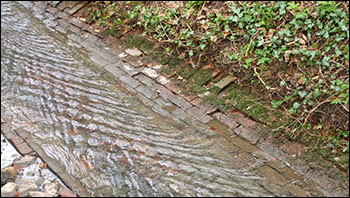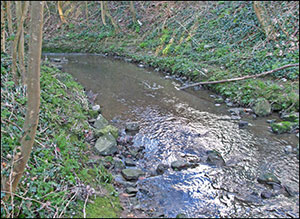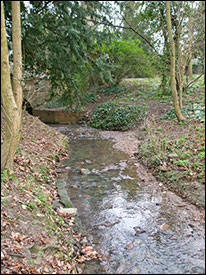|
|||
| Article by Sue Comont based on the minutes of the Sewer Authority in the Northamptonshire Record Office, Ref: Box 1648 | |||
|
Rushden Sewer Authority 1870 – 1872
|
|||
|
|||
|
|
|||
On 19 September 1870 the first meeting of the new Rushden Sewer Authority took place. It had been appointed by the Rushden Select Vestry, the group of leading men in the town who were responsible for parish matters including the regulation of nuisances. The Board of Guardians had made a complaint about the state of the town brook so the Sewer Authority was created to deal with the problem by paving the brook. At the first meeting Messrs Bayes, Margetts and Brooks were invited to tender for the contract of paving the brook.On 26 September, the committee met to consider the tenders. Piggott’s was the highest at 5s 8d (33p) per yard man. Bayes was next with 5s 2d (26p) per yard man but Margetts seriously undercut them both with a bid of 3s 4d (19p) per yard man. The lowest bid, of course, was accepted. The work was to be financed by a rate on the inhabitants which would be levied by the overseers of the poor, and a further meeting of the sewer authority was set for 24 October to send notice to the overseers to provide £150 by means of a rate to both pave the brook and make a reservoir. On 10 October 1870 the authority decided to make a culvert in Mannings Lane, accepting Margett’s tender of 5s 2d (26p) per yard man to do it. Margett’s tender for making a reservoir was also accepted at £61 2s 6d (£61.12), including £2 11s (£2.55) extra for coping in black brick. A meeting on 21 October 1870 saw discussions about the legality of the committee as no notice had been given to the town about its appointment. It was resolved to call a meeting of all the rated inhabitants [all those liable to pay rates and therefore affected by the activities of the sewer authority] on 28 October in the School Room. No record was kept in the minutes of the meeting but on 31 October the clerk recommended that an application should be made to the Highway Board for £100 to pay for the works ordered by the Vestry, and a letter was composed asking for money towards expenses incurred by the parish in consequence of the communication received from the Board of Guardians. On 14 November the complaint by the Board of Guardians was clarified to the Authority. The complaint was about the defective state of the drains emptying into the Town Brook, not about the Brook itself, in which case it was the duty of the Sewer Authority to cause the nuisance to be abated. A meeting had been held and an order was given to the vestry that the nuisance should be removed by the necessary works being done. In future, the committee, properly appointed, would be able to go into the sewer question generally. The committee resolved to buy a seal and ordered 12 forms of the proper precept be printed. The Northamptonshire Union Bank was appointed bankers to the authority and a finance committee was named. It was resolved that a precept should be issued to the Overseers of the Poor to provide £100 and Margetts was ordered to continue with the reservoir at once. No further action was to be taken about paving the Brook for the time being. The finance committee met on 30 December 1870 in some outrage. The £100 had not yet been received by the bank so a letter was written to the Overseers of the Poor, Messrs Denton and Colson, expressing the committee’s astonishment that the sum of £100 had not been collected as it had been stated in the precept that it was to be paid to the account by 23 ultimo [of the last month, ie November]. The committee referred the overseers to section 18 of the Sewage Utilisation Act 1867, page 55, and gave notice that the said sum of £100 must be paid in to the bank without fail, by 21 January 1871. Thankfully, by the time the finance committee met again on 17 February 1871, the chairman was able to report that the £100 had been paid into the bank and £25 withdrawn to pay to Margetts on account of their contract. On 14 March 1871 Mr Margetts attended the finance committee meeting with a statement showing that the contract for both the Brook and the reservoir amounted to £135 5s 10d (£135.29) with a balance owed to him of £55 5s 10d (£55.29). |
|||
On 19 June 1871 Mr Margetts appeared before the finance committee and undertook to stop the leakage and make his work good. No details are given about which of his many contracts this related to but it was probably the reservoir. Summer passed quietly and on 18 September the general committee met at the reservoir to inspect the works and to consider fully the question of the water supply. They resolved to dig up the area to try to find more water. The committee decided next to write to the Chairman of the Gas Company calling his attention to the fact that the gas tar escaped into the Brook and to request that the necessary steps may be taken to prevent this. It was agreed that the Brook should be cleaned out below Wymington Bridge. It was resolved that a notice should be served on F H Sartoris Esq in respect of the nuisance complained of, the fact that the drains from the Hall emptied directly into the Brook, and ordering a cess pit to be made within one month from the date thereof. A notice was also ordered to be served on Mr H Skinner with respect to the blood from the slaughtering process which emptied into the Brook, the said nuisance to be abated within 14 days from the date thereof. The General Committee met again on 18 December 1871 when they decided to form the town – or village as they called it themselves – into three districts for the proper inspection of nuisances. District 1 stretched from the end of the village on the Bedford Road to Wymington Bridge. Inspectors of nuisances here were to be The Rev. R. Bradfield, Mr Perkins and Mr Currie. District 2 ran from Wymington Bridge to Church Lane and Duck St. The inspectors here were Mr Mason, Mr S. Knight and Mr Colson. District 3 went from Church Lane to the lower end of the village, with Mr Foskett, Rev. J.T. Baker and Mr John Goss for inspectors. |
|||
On 8 January 1872 the committee met to consider tenders for paving the Brook. Bids had been received from Piggotts at 2s 4d (14p) for blue bricks, 1s 8d (8p) for red. Margetts bid was also for 1s 8d (8p) while Charles Bayes and Joseph Bayes had both bid 1s 7d (7½p). It was decided to draw lots between Charles and Joseph Bayes as their tenders were for the same amount. The first name drawn was Joseph Bayes and his tender was accepted by the committee who ordered that the work should be completed by 31 May. The committee did not meet again until 5 July 1872 when Mr Joseph Bayes attended and undertook that his contract of paving the Brook should be carried out without any further delay. It was resolved that a notice board should be put up at the Reservoir in consequence of the damage which had been done to the property there, that Mr Perkins should take up the first person trespassing there and that the policeman should also be on the lookout for trouble there. |
|||
|
A precept was signed for the overseers to raise the sum of £23 on or before the 20 Oct 1872. Finally at a general committee meeting on 3 Oct 1872 the Sewer Authority was wound up. A statement of accounts was given and the remaining balance of £24 1s 11d (£24.09) was passed to Mr Sharman on behalf of the Board of Guardians along with the minute book, bank pass book and any outstanding bills. A vote of thanks was given to Mr Currie for acting as chairman to the late Rushden Sewer Authority. |
|||
|
|||


